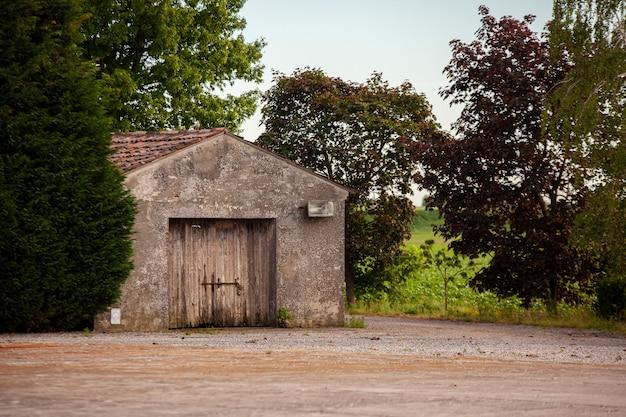Are you the proud owner of a historic building? Do you want to ensure its preservation for future generations? If so, you may want to consider a facade easement.
A facade easement is a legal agreement between a property owner and a preservation organization. It allows the property owner to maintain ownership of the building while restricting certain alterations to its exterior. In essence, the property owner is giving up certain property rights to ensure the building’s historic facade is preserved.
Preservation easements are not new, but they have gained popularity in recent years as more people recognize the importance of protecting historic buildings. The IRS even offers tax benefits to property owners who donate a facade easement to a qualified organization.
However, facade easements can be complicated legal agreements that require careful consideration before signing. It’s essential to understand what a preservation easement entails and how it can affect your property rights. This blog post will provide an in-depth look at facade easements, including how they work, their benefits and potential drawbacks, and what to consider before entering into one.
So, whether you’re a building owner, a preservationist, or just someone curious about historic preservation, read on to learn more about facade easements and how they can help protect our architectural heritage.
Easement Covenant
If you’re looking to make some tax savings as a property owner, you might want to consider an easement covenant. This is a legal agreement between you and a qualified conservation organization, promising to preserve and conserve your property’s natural or historical features. Essentially, you’re giving up some of your rights to use your property in exchange for tax deductions.
Here are some key things you should know about easement covenants:
The Basics
- An easement covenant is a legally binding agreement between you and a conservation organization, where you promise to keep the natural, historic, or scenic features of your property intact.
- The conservation organization will monitor your property’s compliance with the agreement to ensure that you’re keeping your end of the bargain.
- In exchange for the easement covenant, you can claim a tax deduction based on the value of the rights you gave up. This deduction can be up to 50% of your adjusted gross income for the year of the donation and can be carried over for up to 15 years.
- An easement covenant is different from a conservation easement, which requires that you allow public access to your property.
The Benefits
- The primary benefit of an easement covenant is tax savings. You can claim a charitable deduction on your federal income tax return, and in some cases, you may also receive state and local tax benefits.
- By preserving the natural features of your property, you’re also contributing to the community’s environmental and cultural heritage.
- An easement covenant also ensures that your property’s features will be protected long after you’re gone, meaning that your legacy will continue to benefit future generations.
The Drawbacks
- An easement covenant can limit your ability to use your property as you wish. For example, if you have an easement covenant to preserve a historic home, you might not be able to make certain renovations or changes to the property.
- There are significant legal and administrative costs associated with setting up an easement covenant, which can vary depending on the property’s size and location. You’ll need to consult with a qualified conservation organization and an attorney to determine the costs involved.
- An easement covenant is a long-term commitment, and you’ll need to ensure that the conservation organization monitoring your property is trustworthy and financially stable.
An easement covenant can be an excellent way to preserve your property’s natural or historical features while taking advantage of tax deductions. However, it’s important to consider the potential drawbacks and the long-term commitment involved. If you’re interested in pursuing an easement covenant, consult with a qualified conservation organization and an attorney to ensure that you’re making an informed decision.
A Facade Easement is a Type of Conservation Easement
Conservation easements are legal agreements between property owners and land trusts or government agencies to preserve land and biodiversity for future generations. One type of conservation easement is the facade easement, which works to protect historic buildings from alteration or demolition.
A facade easement gives a land trust or preservation organization the right to ensure that the exterior of a building is maintained in a historically accurate or architecturally significant way. The property owner retains ownership of the building and can use it for any purpose, but they must maintain the facade according to the terms of the easement.
Here are some key takeaways about facade easements:
- The purpose of a facade easement is to protect the exterior of a historic or architecturally significant building from alteration or demolition.
- The property owner retains ownership and can use the building for any purpose, but must adhere to the terms of the easement.
- The easement is granted to a land trust or preservation organization, who ensures the facade is maintained according to the agreement.
- The facade easement is a type of conservation easement, which seeks to preserve land and biodiversity for future generations.
If you own a historic building or are interested in preserving historic architecture in your community, a facade easement may be a valuable tool to consider. By working with a land trust or preservation organization, you can ensure that the historic and aesthetic value of your building is preserved for future generations to enjoy.
Facade Easement: Historic Preservation Easement
If you are passionate about preserving historic buildings and sites, then you should consider a historic preservation easement. This type of easement is a legal agreement that protects the historic character and significance of a listed building or site. In this subsection, we will take a detailed look at historic preservation easements, their benefits, and how they can help preserve our nation’s cultural heritage.
What is a Historic Preservation Easement
A historic preservation easement is a legal document that limits the development rights of a property owner to protect the historic character and significance of a listed building or site. Easements are typically granted by the owner of the property to a qualified nonprofit organization or government agency. The easement creates a legally binding agreement that protects the property’s historic features, preventing alterations that could compromise its architectural integrity.
Benefits of a Historic Preservation Easement
There are several benefits to granting a historic preservation easement, including:
- Tax Deductions: Owners who donate a historic preservation easement to a qualified nonprofit organization or government agency can receive a federal tax deduction for the value of the easement.
- Preserving Cultural Heritage: Historic preservation easements ensure that future generations can appreciate the unique historic character and significance of a listed building or site.
- Improved Property Value: Many historic properties have a unique charm and appeal that attracts buyers, and a preservation easement can increase the property’s value.
- Recognition: A historic preservation easement can provide recognition of the property owner’s contribution to preserving our nation’s cultural heritage.
How Do Historic Preservation Easements Work
If you are interested in granting a historic preservation easement, you should follow these steps:
- Contact a qualified nonprofit organization or government agency that specializes in historic preservation easements.
- Work with the organization to determine the property’s historic significance and establish the easement’s terms.
- Record the easement with the government agency responsible for maintaining property records.
- Monitor the property to ensure compliance with the easement’s terms.
Important Points to Consider
- Historic preservation easements are permanent and binding and cannot be reversed without legal action.
- Easements must be granted to a qualified nonprofit organization or government agency to be eligible for tax deductions.
- Some restrictions may apply to alterations or renovations to the property, and the property owner must receive permission before making any changes.
In conclusion, historic preservation easements are an effective way to protect our nation’s cultural heritage. If you own a historic property and want to ensure its preservation for future generations, consider granting a historic preservation easement. Not only will it provide tax benefits, but it will also guarantee that the property’s unique charm and historic significance will be maintained for years to come.
Understanding Preservation Easements
If you’re an owner of a historic property, you may have heard of a preservation easement. But what exactly is it, and how does it work? Let’s dive deeper into this topic.
What is a Preservation Easement
A preservation easement, also known as a conservation easement, is a legal agreement between the property owner and a preservation organization. It is a voluntary agreement that prohibits the alteration or destruction of certain features of a historic building’s exterior, interior, or surrounding landscape. The main goal of a preservation easement is to protect the property’s historic and cultural significance for future generations.
Some common features that may be protected under a preservation easement are:
- Façade and roofline
- Windows, doors, and shutters
- Chimneys, porches, and balconies
- Landscaping and gardens
- Historical artifacts and features
How Does a Preservation Easement Work
When a property owner enters into a preservation easement agreement, they are agreeing to give up certain property rights in exchange for tax benefits and the assurance that their property’s historic and cultural value will be protected. The easement typically grants the preservation organization the right to review and approve any changes or alterations to the protected features of the property.
Once the easement is in place, the property owner is still responsible for maintaining the property. However, the easement ensures that any alterations made will be in line with the property’s historic features and cultural significance.
Key Takeaways
- A preservation easement is a legally binding agreement between the property owner and a preservation organization to protect a historic property’s cultural and historic significance.
- The easement prohibits the alteration or destruction of certain protected features of the property’s exterior, interior, or surrounding landscape.
- The property owner retains ownership and maintenance responsibilities, but any alterations or changes made to the property must be approved by the preservation organization.
- Tax benefits are available for property owners who enter into a preservation easement agreement.
In conclusion, understanding preservation easements is essential for historic property owners who want to protect their property’s historic and cultural significance. These legal agreements not only ensure that the property’s important features are preserved but also provide tax benefits to the property owner.
Facade Easement and IRS Audit Conservation Easement
A facade easement is a legal document that a property owner signs to protect the exterior of a building or structure that is deemed to have historical, architectural, or cultural significance. It restricts future changes to the facade or exterior of the property to preserve its historical or architectural character. When a property owner donates an easement, it may qualify as a charitable contribution for tax purposes. But, it is essential to understand the technicalities of such donations. That’s where the IRS audit conservation easement comes into play.
Understanding the IRS Audit Conservation Easement
An IRS audit conservation easement is a technical review by the Internal Revenue Service when a property owner donates an easement on their property’s facade. Donating an easement can result in a tax benefit for the donor, but it is complicated to figure out the exact tax benefit. As such, the IRS can scrutinize these types of donations to ensure that the claimed deductions are legitimate.
What Triggers an IRS Audit for Conservation Easements
There are several reasons why the IRS may choose to audit a conservation easement donation. Some of the primary reasons include:
- The amount of the claimed charitable contribution deduction is very high
- The easement’s value is overstated
- Poor documentation to support the easement donation
- Lack of adherence to the IRS appraisal rules
- The property owner or the charity donee has a questionable history, reputation, or relationship
How to Ensure Compliance with IRS Regulations
If a property owner is considering donating a facade easement, they must consult with qualified professionals and follow IRS regulations to the letter. Some helpful compliance tips include:
- Working with reputable tax attorneys or conservation easement appraisers
- Obtaining an independent, reliable appraisal of the easement before the donation
- Having proper documents and records to support the charitable donation
- Filing the appropriate IRS forms and schedules
- Ensuring that the easement donation complies with the IRS laws and regulations
Key Takeaways
- A facade easement is a legal document that protects the exterior of a historical or architecturally significant building or structure.
- Facade easement donations are a popular form of charitable giving but can trigger an IRS audit if not done correctly.
- An IRS audit conservation easement is a technical review by the IRS to ensure that the claimed charitable deductions on an easement donation are legitimate.
- Property owners must ensure they comply with all IRS regulations to avoid being audited and ensure that their charitable deductions are valid.
Charitable Contribution of Conservation Easement
Conservation easement is a legal agreement between a landowner and a Land Trust or government agency that permanently limits the use of the land to protect its natural, historical, or cultural resources. By donating or selling a conservation easement, landowners can ensure the land remains protected for future generations while retaining ownership of the land.
If a landowner decides to donate a conservation easement to a qualified land trust, they may be eligible for a charitable contribution deduction on their federal income taxes. The donation can be valued at the fair market value of the easement, which is the difference between the value of the property before and after the easement is in place.
Here are some important things to know about the charitable contribution of conservation easements:
Eligibility
To qualify for a charitable contribution deduction, the donation of the easement must be made to a qualified 501(c)(3) land trust or government agency. Additionally, the easement must be donated in perpetuity, which means it must be permanent and cannot be undone.
Valuation
The value of the conservation easement can vary and is based on specific factors such as the property’s location, development potential, and environmental characteristics. It’s important to note that the IRS scrutinizes the valuation of conservation easements and requires a qualified appraisal of the property.
Tax Benefit
Donating a conservation easement can provide landowners with significant tax benefits. The amount of the deduction is typically based on the fair market value of the easement. Landowners can deduct up to 50% of their adjusted gross income for qualified donations, and any excess can be carried forward for up to 15 years.
Additional Benefits
Aside from the tax benefit, donating a conservation easement can also provide additional benefits such as:
- Protecting natural resources and habitats
- Preserving open space and agricultural lands
- Limiting the potential for development and protecting scenic views
- Increasing the value of surrounding properties
- Demonstrating a commitment to environmental stewardship
In conclusion, donating a conservation easement is a powerful tool for landowners to protect their land while also providing valuable benefits to their community and the environment. With the potential tax benefits and long-term positive impact, it’s a worthwhile consideration for any landowner who values conservation and preservation.



